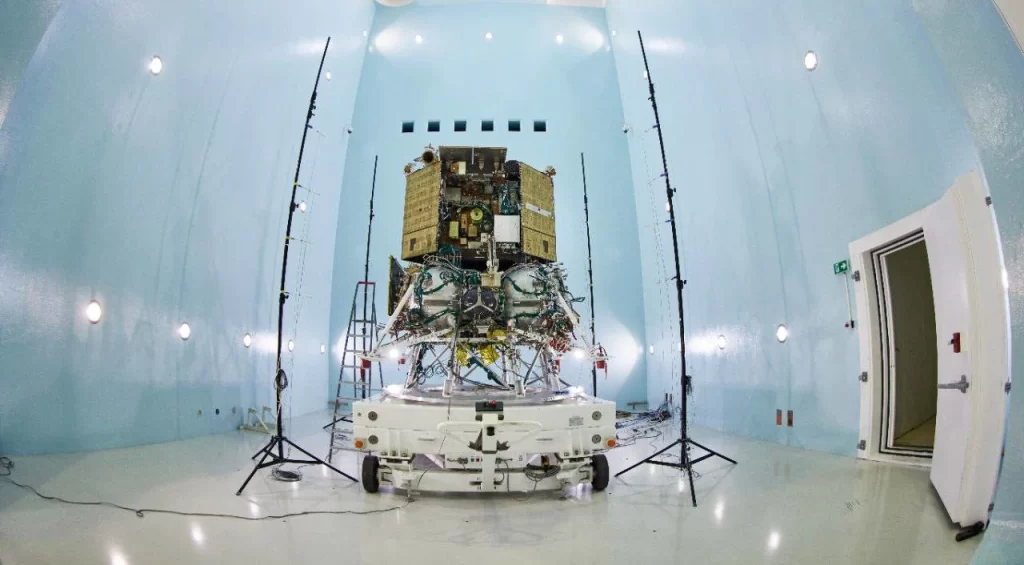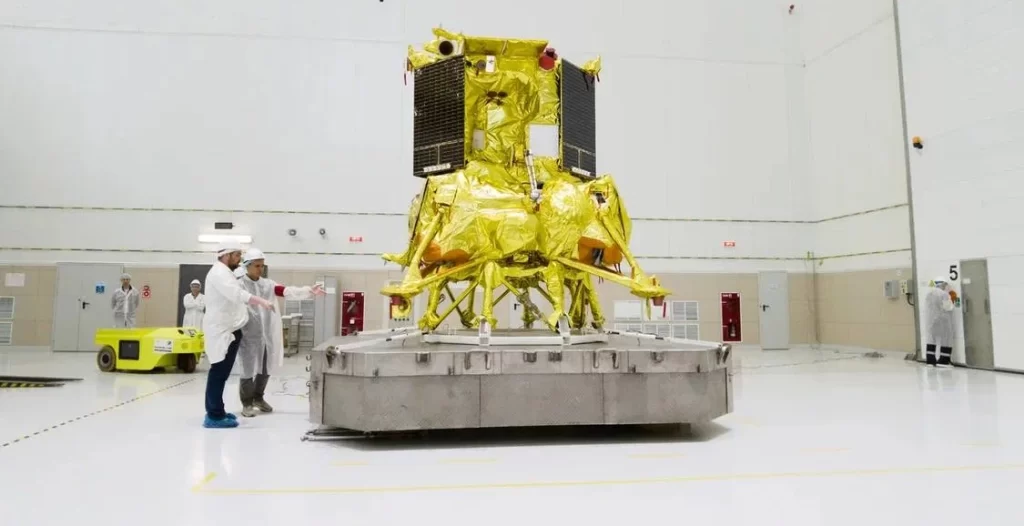The current surge of interest in the Moon can be attributed to the possibility of extracting lunar resources, particularly rare-earth metals linked to metallic meteorites colliding with the Moon throughout its evolution. Furthermore, the significance of investigating the water ice reservoirs located at the lunar poles must be considered in the context of lunar research.
The first Russian lunar station, marking a milestone after half a century, is scheduled to embark on a voyage to the Moon. The scheduled launch of the “Luna-25” automated station aboard the “Soyuz-2.1b” rocket, equipped with the “Fregat” upper stage, is set to take place on August 11th at 2:10 Moscow time from the launch pad located at the Vostochny Cosmodrome.
This lunar outpost will be the first landing near the South Pole of the Moon. “Luna-25” exhibits a fundamental departure from its predecessors. The Soviet lunar stations of the past focused on landing around the equatorial regions. In contrast, the new station has been designed to achieve a soft landing in the near-polar zone, characterised by intricate and challenging terrain.
In contrast to its precursor, the “Luna-24” mission, the upcoming “Luna-25” mission fails to include a return module. Among the key goals of the mission involve the evaluation of soft landing technologies and the exploration of available resources. The “Luna-24” was launched in 1976. The return module retrieved around 170 grams of lunar dirt and safely transported it back to Earth.
To dwell in history a bit, the lunar probe named “Luna-2” achieved the significant milestone of being the first spacecraft to reach the Moon in the year 1959 successfully. As a result of this trip, it was ascertained that the Moon does not possess a magnetic field. The year 1966 witnessed a significant milestone in space exploration with the successful soft landing of the “Luna-9.” This historic achievement involved the transmission of television panoramas capturing the lunar terrain, which were then relayed to Earth. The Luna-16 mission successfully retrieved lunar soil samples and transported them back to Earth using automated procedures, representing a noteworthy achievement.
Luna-25 Mission Objectives
The objectives of the Luna-25 automated station encompass the evaluation of soft landing technology, the acquisition and analysis of lunar soil samples, the execution of comprehensive scientific research, the study of the upper layer of regolith in the vicinity of the lunar South Pole, and the exploration of the lunar exosphere.
According to Lev Zeleny, the scientific head of the Institute of Space Research at RAS, the main aim of the study is to examine and analyse possible water resources on the Moon. This statement was made during an interview with RT. According to his statement, human activities’ primary emphasis lies in exploring the lunar South Pole. This particular interest stems from the significant presence of everlasting permafrost, which indicates the potential availability of water resources. However, additional research is necessary for researchers to determine the amount and possible extent of water.
The “Luna-25” mission must undergo a series of flight stages to reach Earth’s natural satellite and fulfil its objectives successfully. These stages encompass the initial launch of the spacecraft onto a trajectory directed towards the Moon, followed by the spacecraft’s journey to the Moon itself. Subsequently, the spacecraft will enter into a circular near-polar orbit around the Moon, maintaining an altitude of 100 km for three days. Following this phase, the spacecraft will transition into an elliptical landing orbit with a minimum altitude of 18 km and a maximum altitude of 100 km. Finally, the spacecraft will execute a controlled landing near the Moon’s South Pole.
Upon successful touchdown and subsequent alignment of the space station’s directional antenna with Earth, scientific operations for the lunar mission “Luna-25” occur on the lunar surface. The duration of this project is anticipated to span one year. The research programme has been structured to span a period of 12 “lunations,” which correspond to the length of a lunar day and are equivalent to a complete year on Earth. The Moon undergoes a single spin on its axis throughout approximately 28 Earth days. The Moon, in conjunction with Earth, revolves around the Sun, resulting in a temporal expansion of a lunar day by approximately one Earth day, extending its duration to over 29 Earth days.
Luna-25 Module
The lunar spacecraft “Luna-25” has two primary components: a lower section serving as the landing platform and an upper section housing an unsealed instrument container.
The station employs a lightweight instrument container and incorporates specialised thermally stabilised panels to maintain an appropriate temperature for instrument functionality during its duration on the surface. This facilitated a decrease in the spacecraft’s mass and the integration of more scientific instruments for research. Using these scientific instruments, researchers will enhance their understanding of the chemical and mineralogical makeup of the soil found on the lunar surface. Additionally, they will investigate the existence of water ice and examine how the regolith interacts with the solar wind.

The landing platform comprises a propulsion engine and a landing mechanism, which work together to facilitate the spacecraft’s controlled and soft descent. The propulsion system is responsible for executing trajectory corrections throughout the journey to the Moon, initiating the orbit of an artificial satellite around the Moon, decelerating during departure from orbit, and enabling a gentle landing on the lunar surface with near zero velocity. In addition, the platform is equipped with communication antennae, surface contact sensors, and a Doppler speed and range measuring tool.
The non-hermetically sealed instrument container comprises a variety of scientific apparatus, such as thermal control system radiators, electronics, solar panel arrays, radioisotope heat and power sources, television cameras, and antennas.
Survivability of the Mission
Astronomer Vladimir Surdin, in a conversation with RIA Novosti, estimated its chances of Luna-25 mission success at 50%. He said that “misfortune is the beginning.”
He noted that Russia had maintained the qualification level of Soviet space exploration in its theoretical foundation, allowing celestial mechanics to still “carefully” calculate the flight trajectory.
“Regarding the construction of the landing station itself, I think we can expect anything – new engineers, new technologies, a new location – an equatorial region, which is easier to reach than the poles,” the astronomer added.
He also mentioned that during Soviet times, no one paid much attention when several failures occurred before a successful flight because failures were not reported in the media. “Now, it won’t be possible to keep silent, and I’d like to warn – don’t be surprised. The first flight in half a century involves new engineers and new technology. Anything is possible, but misfortune is the beginning,” Surdin said.
Future Missions
After the successful mission of “Luna-25,” the subsequent phase entails launching “Luna-26,” a lunar orbiter specifically designed to operate within a polar orbit. Following this, the upcoming mission known as “Luna-27” will be launched, incorporating an enhanced landing platform equipped with a drilling mechanism to extract soil samples from a depth of around one metre. These samples will then be sent to analytical instruments for thorough examination and research. Subsequently, the mission designated as “Luna-28” is intended to facilitate the retrieval of polar soil from the Moon while preserving all volatile chemicals contained within this soil during the transportation process back to Earth.

